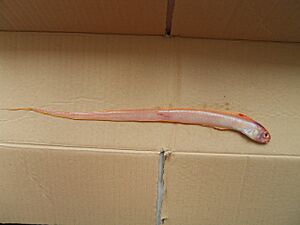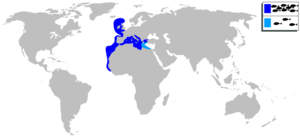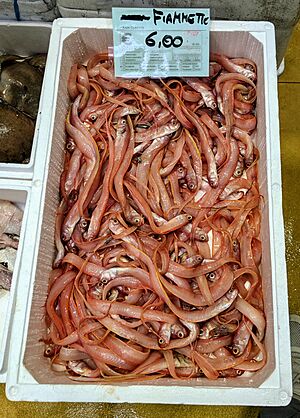Cepola macrophthalma facts for kids
Quick facts for kids Cepola macrophthalma |
|
|---|---|
 |
|
| Conservation status | |
| Scientific classification | |
 |
|
Distribution of Cepola macrophthalma
|
|
| Synonyms | |
|
The red bandfish (Cepola macrophthalma) is a cool type of ray-finned fish that lives in the ocean. It belongs to a group of fish called bandfishes. You can find these fish in the eastern Atlantic Ocean and the Mediterranean Sea. They live from Senegal in the south all the way up to the British Isles. While it's called the red bandfish, other fish in the Cepola family might also share this name.
Contents
About the Red Bandfish
What's in a Name?
The scientific name for the red bandfish is Cepola macrophthalma. This name was first given to it in 1758 by a famous scientist named Carl Linnaeus. He first called it Ophidion macrophthalmum.
Later, in 1764, Linnaeus created the group (or genus) called Cepola. He made Ophidion macrophthalmum the main example for this new group. The name macrophthalma is a mix of two Greek words. "Macro" means "large," and "ophthalmus" means "eyed." This name perfectly describes the fish's big eyes, which are more than one-third the size of its head!
Where Do Red Bandfish Live?
Red bandfish live in the eastern part of the Atlantic Ocean. Their home stretches from northern Senegal to Scotland. They also live in the Mediterranean Sea, west of the Aegean Sea and the Nile Delta.
These fish prefer to live on sandy or muddy parts of the ocean floor. You can find them at depths from about 10 meters (33 feet) down to 400 meters (1,312 feet).
What Does a Red Bandfish Look Like?
The red bandfish has a very unique look. Its body is long and thin, almost like a ribbon. It gets narrower towards its tail, which ends in a point. As its name suggests, it's bright red, but its belly is usually orange or yellow.
It has large, shiny, silver eyes. Its top fin (dorsal fin) and bottom fin (anal fin) run almost the entire length of its body. These fins connect to its tail fin, making them look like one long, continuous fin. The red bandfish also has a big mouth that points upwards. Inside, it has thin, widely spaced teeth that look like glass.
Red bandfish can be different lengths. On average, they are about 40 centimeters (15.7 inches) long. The longest one ever recorded was 80 centimeters (31.5 inches) long!
How Do Red Bandfish Live?
For a long time, scientists didn't know much about how red bandfish behaved. Then, a group of them was found off the coast of Lundy island in Devon, England. Since then, many studies have been done on these fish, both in the wild and in tanks. The number of red bandfish at Lundy has dropped a lot, even though fishing is not allowed there.
These fish are amazing burrowers. They dig homes in the sand or mud. They often stick their bodies out of their burrows to catch tiny creatures called zooplankton for food. Unlike some other burrowing fish, red bandfish can move around inside their burrows and even leave them.
Their burrows have a fun, funnel-shaped opening. This is because they push out a lot of mud and sand when they dig. The burrows are usually single, straight shafts that go down into the ground. At the bottom, there's a small chamber. These burrows can be up to 1 meter (39 inches) deep, but about 49 centimeters (19 inches) is more common.
Red bandfish dig and keep their burrows tidy around sunrise or sunset. They use their mouths to dig and push mud with their bodies. They can move about three liters (three-quarters of a gallon) of mud and sand to build one burrow. It takes them about six hours to build a new home. Sometimes, their burrows even connect with the burrows of crabs or other fish and crustaceans. This might be on purpose!
Red bandfish are an important food source for many ocean animals. Fish like John Dories love to eat them. Other predators include common dolphins and a type of octopus called the musky octopus. Scientists think red bandfish might have started burrowing and eating zooplankton because there were so many predators trying to eat them.
Red Bandfish as Food
In the past, red bandfish were an important fish to eat. The oldest known recipe for fish, written by a Greek cook named Mithaecus, was actually for this species! It said: Tainia: gut, discard the head, rinse, slice; add cheese and oil. Tainia was the name the ancient Greeks used for the red bandfish. The oil they used was olive oil.
Today, red bandfish are not as commonly eaten. In some countries, like Italy and Spain, people still enjoy them. But in other places, like Greece, fishermen often throw them back if they catch them while trying to get other fish. In Britain, deep-sea anglers (people who fish for sport) really like catching them. Unfortunately, catching these fish without permission is a big problem for the red bandfish population at Lundy.



